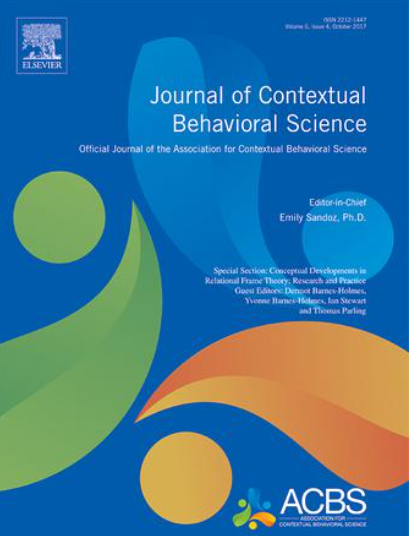派生层次响应。范围审查
IF 3
3区 心理学
Q1 PSYCHOLOGY, CLINICAL
引用次数: 0
摘要
层次网络被定义为刺激的类别(例如,“活的有机体”),包括子类(例如,“植物”,“动物”),这些子类又包含进一步的子级别(例如,“猫”,“狗”,“树”,“草”)。这种类型的反应与概念学习、语言发展、精神病理学和教育等领域相关。人们从不同的理论角度对其进行了研究,包括行为方法。在这种背景下,关系框架理论(RFT)通过将这些反应概念化为衍生关系反应,促进了对这些反应的实验分析。本综述分析了16项实验研究,这些研究训练了层次网络并测试了衍生的关系反应。这些研究是根据prisma - scr指导的范围审查确定的。本综述纳入了符合以下标准的研究:(1)至少有一个自变量的实验操作;(2)跨两个或多个层次的训练分类;(3)测试衍生的或未经训练的反应;(4)在同行评议的期刊上发表。本文考察了训练方法、网络复杂性和网络内的衍生反应。在确定的所有研究中,有7项研究训练非任意分类反应,而9项研究侧重于任意网络。其中,在训练变量、网络结构(刺激数量、分支等)和衍生函数测试中存在可变性。总的来说,关于复杂的层次响应,特别是跨层次和分支的派生函数,文献仍然稀缺和碎片化。未来的研究应明确训练条件,建立分层响应,并进一步探索其定义特征。本文章由计算机程序翻译,如有差异,请以英文原文为准。
Derived hierarchical responding. A scoping review
Hierarchical networks are defined as classes of stimuli (e.g., “living organism”) that include subclasses (e.g., “plants,” “animals”), which in turn contain further sublevels (e.g., “cats,” “dogs,” “trees,” “grass”). This type of responding is relevant in domains such as concept learning, language development, psychopathology, and education, among others. It has been studied from various theoretical perspectives, including behavioral approaches. In this context, Relational Frame Theory (RFT) has facilitated the experimental analysis of such responses by conceptualizing them as derived relational responding. This scoping review analyzes 16 experimental studies that trained hierarchical networks and tested derived relational responses. The studies have been identified following PRISMA-ScR-guided scoping reviews. The review included studies that met these criteria: (1) experimental manipulation of at least one independent variable; (2) training categorization across two or more hierarchical levels; (3) testing derived or untrained responses; and (4) publication in peer-reviewed journals. The review examines training methods, network complexity, and derived responses within the networks. Of the total of studies identified, seven studies trained non-arbitrary classification responses, while nine focused on arbitrary networks. Among these, there was variability in training variables, network structure (number of stimuli, branches, among others), and derived functions tested. Overall, the literature remains scarce and fragmented regarding complex hierarchical responding, especially the derived functions across levels and branches. Future research should clarify training conditions to establish hierarchical responding and further explore its defining features.
求助全文
通过发布文献求助,成功后即可免费获取论文全文。
去求助
来源期刊

Journal of Contextual Behavioral Science
PSYCHOLOGY, CLINICAL-
CiteScore
8.50
自引率
18.00%
发文量
82
审稿时长
61 days
期刊介绍:
The Journal of Contextual Behavioral Science is the official journal of the Association for Contextual Behavioral Science (ACBS).
Contextual Behavioral Science is a systematic and pragmatic approach to the understanding of behavior, the solution of human problems, and the promotion of human growth and development. Contextual Behavioral Science uses functional principles and theories to analyze and modify action embedded in its historical and situational context. The goal is to predict and influence behavior, with precision, scope, and depth, across all behavioral domains and all levels of analysis, so as to help create a behavioral science that is more adequate to the challenge of the human condition.
 求助内容:
求助内容: 应助结果提醒方式:
应助结果提醒方式:


